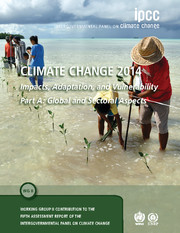 Climate Change 2014 – Impacts, Adaptation and Vulnerability: Part A: Global and Sectoral Aspects
Climate Change 2014 – Impacts, Adaptation and Vulnerability: Part A: Global and Sectoral Aspects Book contents
- Frontmatter
- Contents
- Foreword, Preface, and Dedication
- Summary for Policymakers
- Technical Summary
- Cross-Chapter Boxes
- Chapters 1-20
- Chapter 1 Point of Departure
- Chapter 2 Foundations for Decision Making
- Chapter 3 Freshwater Resources
- Chapter 4 Terrestrial and Inland Water Systems
- Chapter 5 Coastal Systems and Low-Lying Areas
- Chapter 6 Ocean Systems
- Chapter 7 Food Security and Food Production Systems
- Chapter 8 Urban Areas
- Chapter 9 Rural Areas
- Chapter 10 Key Economic Sectors and Services
- Chapter 11 Human Health: Impacts, Adaptation, and Co-Benefits
- Chapter 12 Human Security
- Chapter 13 Livelihoods and Poverty
- Chapter 14 Adaptation Needs and Options
- Chapter 15 Adaptation Planning and Implementation
- Chapter 16 Adaptation Opportunities, Constraints, and Limits
- Chapter 17 Economics of Adaptation
- Chapter 18 Detection and Attribution of Observed Impacts
- Chapter 19 Emergent Risks and Key Vulnerabilities
Chapter 5 - Coastal Systems and Low-Lying Areas
Published online by Cambridge University Press: 05 January 2015
- Frontmatter
- Contents
- Foreword, Preface, and Dedication
- Summary for Policymakers
- Technical Summary
- Cross-Chapter Boxes
- Chapters 1-20
- Chapter 1 Point of Departure
- Chapter 2 Foundations for Decision Making
- Chapter 3 Freshwater Resources
- Chapter 4 Terrestrial and Inland Water Systems
- Chapter 5 Coastal Systems and Low-Lying Areas
- Chapter 6 Ocean Systems
- Chapter 7 Food Security and Food Production Systems
- Chapter 8 Urban Areas
- Chapter 9 Rural Areas
- Chapter 10 Key Economic Sectors and Services
- Chapter 11 Human Health: Impacts, Adaptation, and Co-Benefits
- Chapter 12 Human Security
- Chapter 13 Livelihoods and Poverty
- Chapter 14 Adaptation Needs and Options
- Chapter 15 Adaptation Planning and Implementation
- Chapter 16 Adaptation Opportunities, Constraints, and Limits
- Chapter 17 Economics of Adaptation
- Chapter 18 Detection and Attribution of Observed Impacts
- Chapter 19 Emergent Risks and Key Vulnerabilities
Summary
5.1. Introduction
This chapter presents an updated picture of the impacts, vulnerability, and adaptation of coastal systems and low-lying areas to climate change, with sea level rise perceived as the most important risk for human systems. Unlike the coastal chapter in the previous assessment (Fourth Assessment Report, AR4), materials pertinent to the oceans are not covered here but in two new ocean chapters (Chapters 6 and 30). As in AR4, polar coasts are in another chapter (Chapter 28); small islands are also considered separately (Chapter 29) so an in-depth discussion is not provided herein.
The topics covered in this chapter follow the outline for sectoral chapters approved by the IPCC. An Executive Summary summarizes the key messages with a line of sight to the supporting sections in the chapter.
This chapter consists of six sections, with this first section dealing with progress in knowledge from AR4 to AR5 (Fifth Assessment Report), scope of chapter, and new developments. Section 5.2 defines the coastal systems and climate and non-climate drivers. The coastal systems include both natural systems and human systems, and this division is generally followed throughout the chapter. The climate and non-climate drivers are assessed in Section 5.3, followed by the impacts, vulnerabilities, and risks in Section 5.4. Section 5.5 deals with adaptation and managing risks. Information gaps, data gaps, and research needs are assessed in Section 5.6. There is one box on a specific example and reference to three cross-chapter boxes.
In AR4, the coastal chapter assessed the impact of climate change and a global sea level rise up to 0.59 m in the 2090s. The coastal systems were considered to be affected mainly by higher sea levels, increasing temperatures, changes in precipitation, larger storm surges, and increased ocean acidity. Human activities had continued to increase their pressure on the coasts with rapid urbanization in coastal areas and growth of megacities with consequences on coastal resources. Regionally, South, Southeast, and East Asia; Africa; and small islands were identified as most vulnerable.
- Type
- Chapter
- Information
- Climate Change 2014 – Impacts, Adaptation and Vulnerability: Part A: Global and Sectoral AspectsWorking Group II Contribution to the IPCC Fifth Assessment Report, pp. 361 - 410Publisher: Cambridge University PressPrint publication year: 2014
- 18
- Cited by


